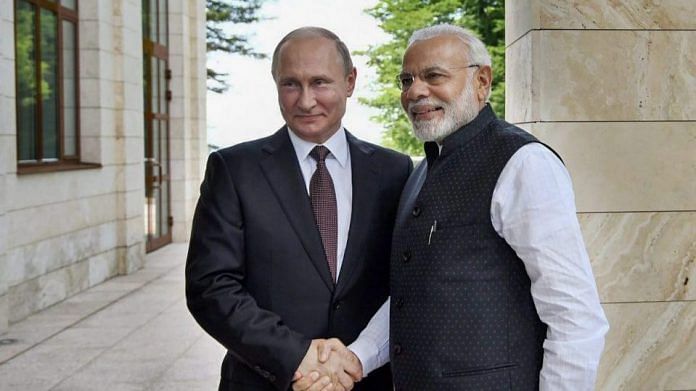The 2 stealth frigates will be built by Goa Shipyard Ltd and are expected to be delivered by 2027.
New Delhi: India and Russia will on Tuesday hammer out a $500 million contract to build two stealth frigates in Goa that are expected to be delivered by 2027, two officials familiar with the development said on condition of anonymity.
Russia’s state-run arms exporter Rosoboronexport and India’s Goa Shipyard Limited (GSL) will sign the contract in New Delhi to build the Grigorovich-class ‘Project 1135.6’ frigates with technology transfer from Russia, which is India’s top arms supplier.
The deal comes just weeks after the two countries inked a nearly $1 billion deal to import two other such warships from Russia. Those ships are being built at the Yantar Shipyard in Kaliningrad and are expected to be delivered to the Indian Navy by 2022-23.
A government official said the warships being built in India will eventually cost a lot more than $500 million, which is only the upfront value of the deal. “The $500 million is for the foreign content in the vessels including material, design and specialist assistance. The frigates will cost more factoring in the indigenous content. That cost is being worked out,” he said.
GSL is expected to deliver the first frigate in 2026 and the second a year later, a second official added.
The frigate deal comes a month-and-a-half after India signed a R39,000-crore deal with Russia for the supply of Russian S-400 Triumf air defence missile systems to India, brushing aside Washington’s concerns about the purchase. Both the S-400 and the frigate deal are likely to be affected by the US sanctions legislation if India is unable to secure a waiver.
India is in talks with the US to secure a waiver from the Countering America’s Adversaries through Sanctions Act (Caatsa), arguing that its military is heavily dependent on Russian equipment and the two countries share a unique, time-tested relationship.
India is simultaneously exploring ways to bypass the US sanctions including an alternative payment route for Russian equipment.
The Caatsa legislation passed earlier this year does provide some flexibility for countries such as India that are dependent on Russian equipment, but Washington wants India to diversify its suppliers of military equipment and reduce dependence on Russian military hardware
India inked an Inter-Governmental Agreement (IGA) with Russia for the four frigates in 2016. The Indian Navy currently operates six such stealth frigates — three Talwar class and three Teg class — bought from Russia and inducted between 2003 and 2013.
“The best thing is the navy will now have 10 warships in the same class. That’s rare. These ships have proved to be reliable, have good weapons and sensors and new ones will further sharpen our capabilities,” said Admiral Arun Prakash, a former navy chief.
The Grigorovich-class frigates will be powered by gas turbine engines supplied by Ukrainian firm Ukroboronprom’s Gas Turbine Research & Production Complex Zorya-Mashproekt, the officials said.
Also read: Beyond defence deals like S-400, there’s not much left to India-Russia ties
By special arrangement with ![]()




The Russian Navy’s has a huge maintenance problem which they haven’t been able to address. Many of its blue-water ships, including its only aircraft carrier, never leaves port without an ocean-going tug in attendance – to power the naval vessel in the event of engine failure.
And then the ultimate ignominy – Russia’s largest
floating dry dock, also considered one of the largest floating docks in the world, sinks after an accident. As the dock was sinking, two of its large tower cranes collapsed. One of these falling tower cranes made a gaping hole in the hull of Russia’s sole aircraft ‘Admiral Kuznetsov’, above the waterline.